NYC’s Forgotten ‘War on Christmas Trees’
Discover how an obscure holiday crackdown affects festive street vendors today!


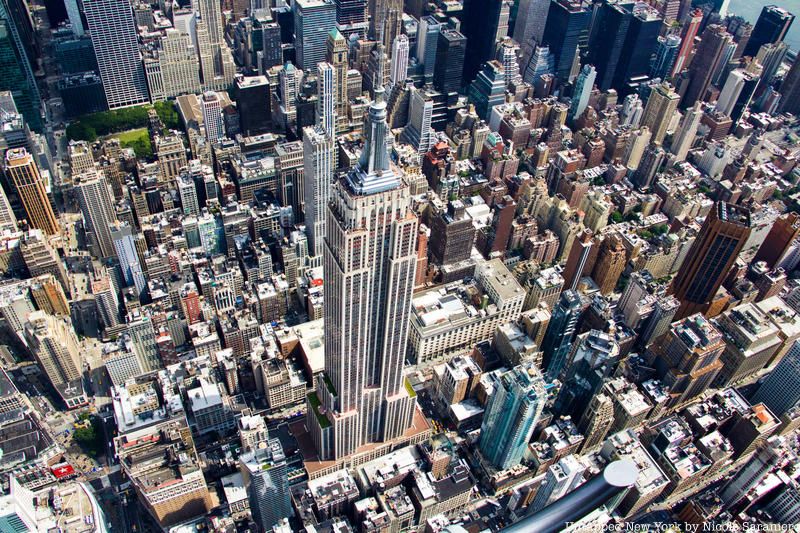
Skyscrapers: boon or blight? That appears to be the perennial question. For architect Cass Gilbert, designer of the famous Woolworth Building, the high-rise was a “machine which makes the land pay,” a response to various needs in the modern era of urbanization. But to critics, they were “freak” buildings destroying the ‘good city’ in a vainglorious attempt to create monuments by and for builders. In our time, that debate continues, more or less in the same terms.
A survey by the Skyscraper Museum found that there are only 58 buildings in the world that surpass 1,250 feet — the height of the Empire State Building — seven of which are located in New York City. The survey includes all buildings that in fall 2019 were believed to have a completion date by 2024.
Only one structure in the world, the Eiffel Tower, reached the height of 1,000 feet before 1929. The Chrysler Building reached its spire to 1,046 feet, and in 1930, the Empire State stretched to 1,250 feet. Supertalls were quite rare in the 20th century — the only supertalls constructed by 1974 were the Empire State, the Twin Towers of the World Trade Center, and Chicago’s Sears Tower. The first international supertalls were office buildings in southern China’s Pearl River Delta: Shun Hing Square in Shenzhen and CITIC Plaza in Guangzhou, both completed in 1996. In 1998 the twin Petronas Towers in Kuala Lumpur took the title of “world’s tallest building” away from the United States for the first time. The last of the 20th century’s giants was the slender Jin Mao Tower in Shanghai.
The development strategy of these supertalls is to pack as much of the FAR (floor area ratio) as possible into a very small footprint, especially since there are zoning restrictions on the FAR in New York. Architects and developers also tried to raise each floor of apartments as high up as possible to capture spectacular views. Elevators could be reduced to two to five shafts, unlike an office building, which also keeps the FAR profitable for the developer.
Since 2014, New York skyscrapers began to blossom. First came One World Trade Center in 2014, then just a year later 432 Park Avenue — which drew quite a lot of criticism. 2019 saw the opening of 30 Hudson Yards, and 2020 was an exciting year for supertalls as One Vanderbilt, 111 West 57th St and Central Park Tower all were completed. Learn more about the history and features of New York skyscrapers. Here are New York City’s seven supertalls!
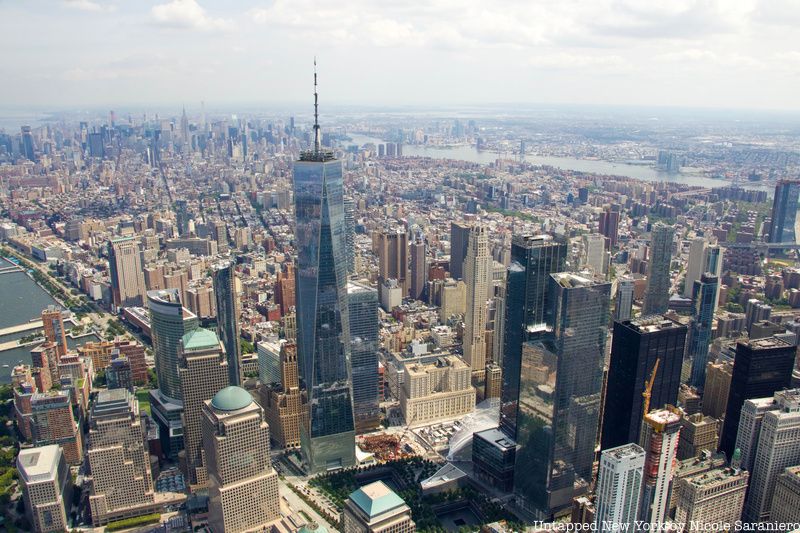
One World Trade Center, previously known as the Freedom Tower and one of the most recognizable New York skysrapers, is the tallest building in the U.S. and in the Western Hemisphere, as well as the sixth tallest in the world. The building stands at the symbolic height of 1,776 feet, in honor of the year in which the Declaration of Independence was signed. The height includes 408 feet of the spire. The building’s architect is David Childs, whose firm Skidmore, Owings & Merrill also designed the tallest building in the world, the Burj Khalifa, and the Willis Tower. It overtook the Empire State Building as the tallest structure in New York City on April 30, 2012.
Floor area was as significant as height in the 1960s and ‘70s in the construction of supertalls. Each of the Twin Towers of the original World Trade Center independently qualified as the world’s largest building — with a floor area of 4.5 million square feet — as well as the world’s two tallest buildings at 1,363 and 1,368 feet. In the aftermath of the 9/11 attacks, many predicted the end of skyscrapers, since people would be too afraid to work or live in them. Yet these fears were short-lived since the construction of the 94-story building began as early as 2006. One World Trade Center has an area of 40,000 square feet, nearly identical to the footprints of the original Twin Towers. Remnants of the original World Trade Center are still located near One World Trade Center, including the Twin Tower tridents, the slurry wall, the Koenig Sphere and the Survivor Tree.
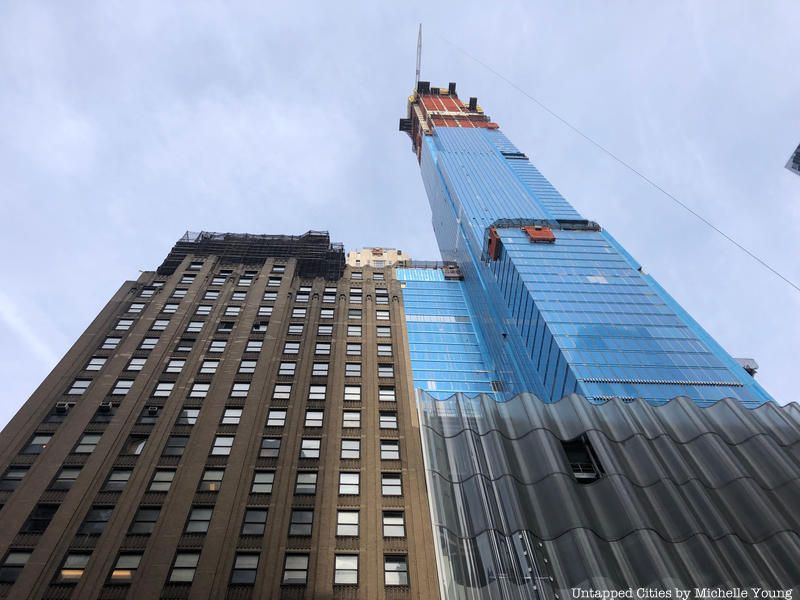
Central Park Tower, also known as the Nordstrom Tower, sits at 225 West 57th Street in Midtown Manhattan along Billionaires’ Row. Designed by Adrian Smith + Gordon Gill Architecture, the building rises 1,550 feet with 98 above-ground stories and three basement stories. Central Park Tower is the second-tallest skyscraper in the U.S. and the Western Hemisphere, as well as the tallest residential building in the world. The basement and the first five above-ground stories contain a large Nordstrom store. Above-ground construction started in early 2015, and despite some controversies during the building’s construction, the building was topped out in September 2019 and completed in July 2021.
The tower was delayed after two buildings at 225 West 57th Street and 1780 Broadway were considered for New York City landmark status. Controversially, the eastern portion of the tower features a cantilever above the Art Students League of New York‘s building at 215 West 57th Street, which was created to maximize views of Central Park. This resulted in a number of lawsuits and controversies concerning the air rights sale. There were also multiple construction incidents, such as the death of a security guard when a truck driver accidentally hit a 3,000-pound glass panel on the ground floor, which then tipped over. The $3 billion building now features outdoor terraces, an indoor pool, steam rooms and a three-floor private club.
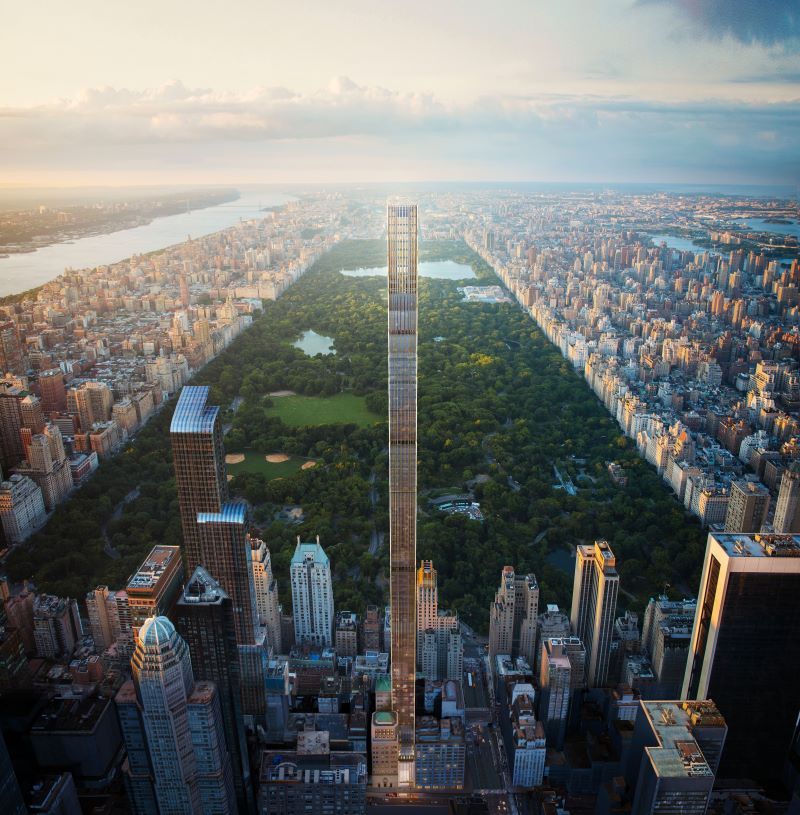
111 West 57th Street, also known as Steinway Tower, is situated along Billionaires’ Row on 57th Street. The main portion of this New York skyscraper is an 84-story, 1,428-foot tower designed by SHoP Architects, and the 16-story Steinway Hall, a former Steinway & Sons store, is preserved at the base of the skyscraper. 111 West 57th Street has 60 luxury condominiums, It is the thinnest skyscraper in the world with a width-to-height ratio of about 1:24.
The Steinway & Sons store opened in 1925 at Steinway Hall, serving as a store, recital hall and office building for almost nine decades. Steinway Hall contains a facade of brick, limestone and terracotta, which was restored as part of the residential development. Work on the tower faced several challenges, such as financing difficulties, lawsuits and employment controversies. 111 West 57th Street, with a facade of large glass curtain walls and narrow windows between vertical piers of glazed terracotta, features an expansive outdoor terrace, a sheltered porte-cochère and an indoor pool.
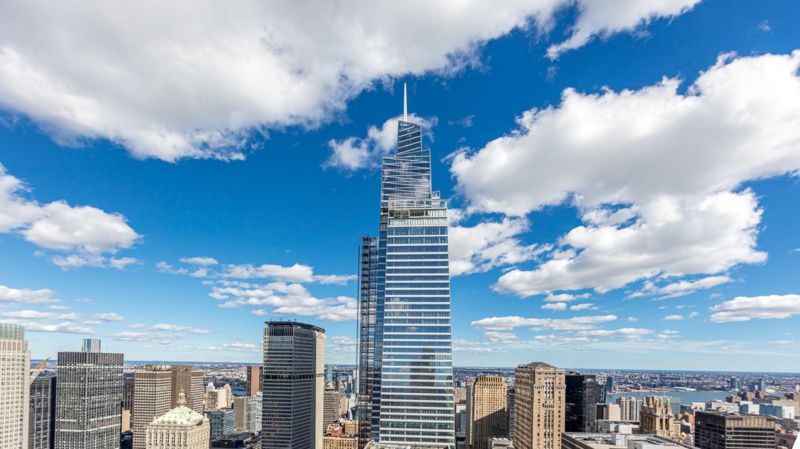
One Vanderbilt is a 77-story New York skyscraper at the corner of 42nd Street and Vanderbilt Avenue. The skyscraper’s roof is 1,301 feet high and its spire is 1,401 feet above ground. Kohn Pedersen Fox designed the building to harmonize with the nearby Grand Central Terminal, with a facade made mostly of glass panels with terracotta spandrels. The tower narrows as it rises, and its base contains a wedge-shaped void. Although most of the building is office space, the second floor contains Daniel Boulud’s new restaurant Le Pavillon, while its observation deck called Summit opened on October 21, 2021. Five buildings were taken down so that One Vanderbilt could be built, including a popular coffee shop.
New York City’s zoning rules are based on FAR (floor area ratio), and the designated rules in Midtown at the time of planning would have permitted a maximum massing reaching only around 600 feet in height for One Vanderbilt. However, developer SL Green owned the Bowery Savings Bank on 42nd Street, home to Cipriani. The 1961 Landmarks Preservation Law allows the transfer of air rights not just adjacent to a building but up to several blocks away, meaning that One Vanderbilt gained 100 feet by the transfer of air rights from the landmarked Bowery Savings Bank about half a block away. Mayor Bill De Blasio’s administration agreed in 2015 to rezone five blocks on Vanderbilt Avenue that allowed SL Green to add another 700 feet to the giant tower. The agreement required SL Green to aid the MTA by spending $220 million for transportation improvements around One Vanderbilt and Grand Central Terminal, including the restoration of a long-closed passageway.
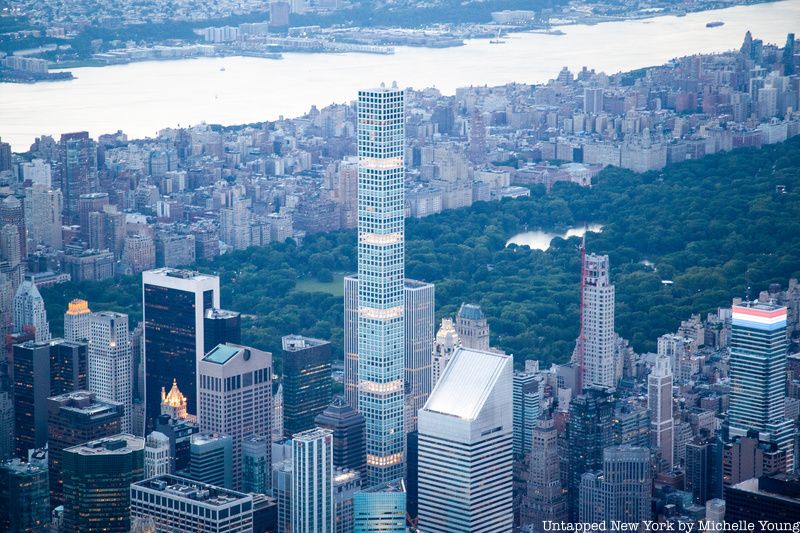
432 Park Avenue is a residential skyscraper at 57th Street and Park Avenue, overlooking Central Park. The 1,396-foot-tall tower was developed by CIM Group and Harry B. Macklowe and designed by Rafael Viñoly, an Uruguayan architect. The building includes 125 condominiums and a private restaurant just for residents, with some of the most expensive units on the New York market. Completed in 2015, the building is segmented into 12-story blocks separated by two-story mechanical spaces allowing wind gusts to pass through the building. Its construction even required approval from the Federal Aviation Administration, with a height to width ratio of 15:1. The building’s height was permitted by zoning regulations partly because a quarter of the building’s floor area is devoted to structural and mechanical equipment.
432 Park Avenue is situated on the site of the former Drake Hotel, which was sold in 2006. It was built in 1926 by Bing & Bing and included 495 rooms, catering to guests like Frank Sinatra, members of Led Zeppelin, Judy Garland and Muhammad Ali. After purchasing the hotel for $418 million, Macklowe paid French delicatessen company Fauchon $4 million to shorten the terms of their lease on the ground floor of the Drake Hotel, vacating nine years earlier than they were supposed to. The property was soon demolished, and construction plans were approved for 432 Park Avenue in 2011. Now, the pencil tower includes 12-foot ceilings, golf training facilities, a fitness center with a pool, and a private terrace.
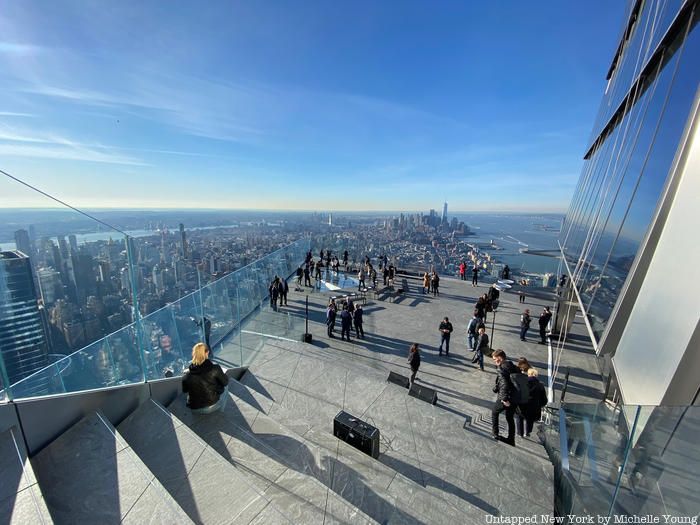
30 Hudson Yards near Hell’s Kitchen and Chelsea soars over other new high rises in Hudson Yards, measuring 1,270 feet with 103 floors. The building is part of the Hudson Yards Redevelopment Project, which has redeveloped the MTA’s West Side Yard. The neo-futurist building houses offices for WarnerMedia, Wells Fargo, Facebook, and Kohlberg Kravis Roberts. The groundbreaking ceremony took place on December 4, 2012, and the building opened on March 15, 2019.
Kohn Pedersen Fox, the firm behind One Vanderbilt, was chosen for the design of 30 Hudson Yards, which was supposed to be even taller at 1,337 feet. Featured in the building’s lobby is Spanish artist Jaume Plensa’s Voices, which consists of 11 variously sized steel orbs suspended from the ceiling. 30 Hudson Yards is also known for its outdoor observation deck “The Edge”, located on the 100th and 101st floors. The Edge’s terrace juts 80 feet outward south of the building, with clear glass barricades surrounding the perimeter. It is the second-highest observation deck in New York City after One World Observatory.

New York skyscrapers owe a debt to the Empire State Building, which was built following a boom in high-rise office construction in the late 1920s that added over a dozen 40-50-story towers. According to the Skyscraper Museum exhibition website, “The Empire State was not a typical tower of 600 to 800 feet: its 86th floor leveled off at 1,050 feet and the tip of its mooring-mast spire reached the altitude of 1,250 feet/381 meters. Not only was the Empire State 50 to 25 percent taller than its contemporaries, but it was also more than twice as big in its floor area – 2.1 million square feet. (as measured at the time: now 2.6 million), in contrast with the 900,000 square feet of the Chrysler Building.”
Built atop the original Waldorf-Astoria Hotel, the Empire State Building opened on March 31, 1931, and took only one year and 45 days to build, rising at 4.5 floors per week. In 1931, tickets to the observatories cost $1 (or about $17.50 in today’s dollars), the most expensive observation deck in the city at the time. When the Empire State Building was built, it had the fastest elevators in the world, moving at 800 feet per minute up and down seven miles of elevator shafts. The law in New York City at the time stipulated that elevators could not exceed speeds of 600 feet per minute, so the regulation had to be overturned just for the Empire State Building. You can still see the last original elevator, an abandoned bank vault, wind tunnels and a river below the basement, and a steam power plant on site. New renovations on the 102nd floor observation deck, the 80th floor, and the lobby, which include museum-style exhibitions, have rejuvenated the Empire State Building experience for the 21st century.
Next, check out the Top 10 Secrets of the Empire State Building!
Subscribe to our newsletter